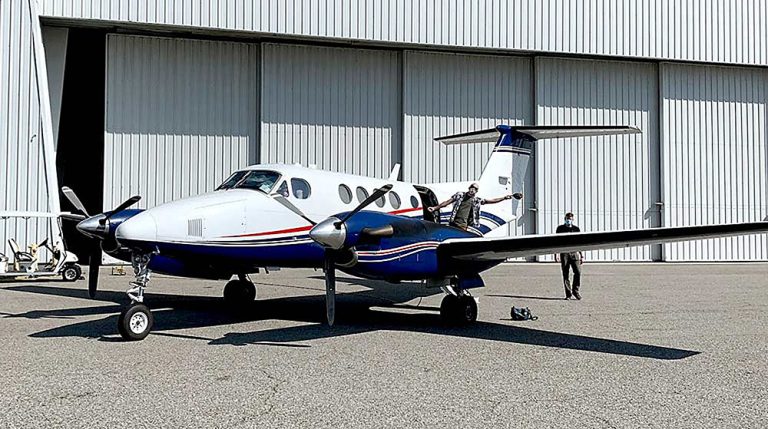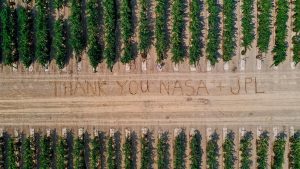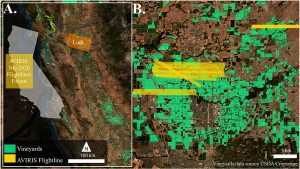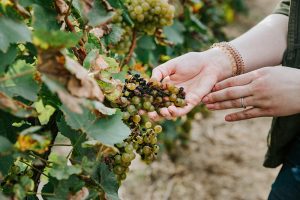
A group of researchers have tapped NASA Jet Propulsion Laboratory’s hyperspectral imaging equipment and machine learning expertise to see if they can detect virus-infected grapevines before they exhibit visible symptoms. Although similar technology has been used to identify bacterial and fungal infections in asymptomatic plants and trees, it had not been used to detect viruses in asymptomatic vines until now, said Katie Gold, an assistant professor of grape plant pathology with Cornell University’s AgriTech in Geneva, N.Y. She is leading a Cornell research group collaborating with the Jet Propulsion Lab.
The theory is that by identifying asymptomatic grapevines infected with grapevine leafroll-associated virus complex 3, growers would be able to remove them earlier in the disease cycle.
GLRaV-3 has a latent period of about 12 months, and often times more, depending on the variety, where vines are infected but don’t express symptoms. The longer infected vines remain in a vineyard, the greater the potential for them to spread GLRaV-3 to nearby plants.
Based on two years of work with 300 acres of grapevines in the Lodi production area, Gold said they were able to identify asymptomatic red varieties with 87% accuracy. Although she said they were “very pleased” with the results, she also pointed out it wasn’t perfect.
For example, the machine learning model at times misidentified vines affected by the drought or other abiotic stressors mostly along vineyard edges.
“What we will work on is maintaining accuracy but reducing misclassification,” Gold said. “This is the low-hanging fruit, and we know we can improve our methods because we can improve our corrections.”
She also said she doesn’t see remote sensing technology replacing the need for PCAs and crop scouting but instead helping them be more efficient.

A Promising Tool
Charlie Starr IV, a Lodi-area PCA who was part of the research project, said while hyperspectral imaging holds promise, it still has several unanswered questions.
He has been working with a vineyard client for several years to try to reduce the number of GLRaV-3-infected vines in a young vineyard by rouging. Unlike some areas of the state where grapevine red blotch disease is the predominant virus, Starr said GLRaV-3 is the leading one in the Lodi area.
Mealybug, which are endemic to the region, are the main GLRaV-3 vectors. Since it would be nearly impossible to try to eradicate mealybugs, he said they are focusing on eliminating infected vines.
“We know we can’t eliminate the vector, so that only leaves one other option: Try to get rid of the virus,” Starr said.
But that doesn’t mean they ignore mealybug. He and his client have taken an integrated approach that uses insecticides as well as mating disruption to bring pest numbers down as low as possible.
“It’s correct that we know we will not eradicate the mealybug. However, if we let the populations build, we’re only allowing more bugs to vector the virus quicker,” Starr said. That’s where he said a neighborhood mealybug effort that enlists nearby growers is important since the pest can move and be transported between vineyards.

Depending on the season and other environmental factors, GLRaV-3-infected red varieties near harvest typically express visual symptoms compared with white varieties, which usually don’t.
Over the years, the client’s scouting crew has become skilled at identifying red varieties infected with the virus. But white varieties typically go unscouted because of a lack of visual symptoms.
“If we can refine [the technology] to where we can actually identify viruses in white and in red varieties, but more importantly in white varieties, that will be a game changer for us to get an upper hand on viruses,” Starr said.
He and his vineyard client’s efforts took on new urgency with the advent of sudden vine collapse several years ago.
UC researchers conducted PCR testing of affected vines to try to solve the mystery in 2019 at the request of the Lodi Winegrape Commission. They identified co-infections of leafroll virus and grape vitiviruses and believed the combination was responsible for what has been dubbed “sudden vine collapse.”
Certain rootstocks like Freedom also appear more sensitive. And like leafroll virus, grape vitiviruses can be vectored by mealybugs and scale insects.

Remote Sensing 101
At the basic level, remote sensing involves measuring how much light, or electromagnetic radiation, an object or area reflects or absorbs. This is known as its spectral signature.
The electromagnetic spectrum includes all the kinds of light, both visible to the human eye and the larger portion that is not visible.
Our eyes can only see the visible portion (red, green and blue). Healthy vegetation typically appears green because it absorbs more blue and red light and reflects more green.
But vegetation reflects even more light in specific near-infrared channels. As a result, many growers and consultants have begun flying off-the-shelf drones equipped with near-infrared sensors to measure light reflectance and plant health. By imaging an area and creating a map, they can identify stressors including diseases symptoms that may not be visible just by walking a crop.
Gold and her group have taken that concept to an entirely new level and are using hyperspectral imaging to assess grapevine health. Any digital image, whether viewed on a cellphone or high-powered computer, is made up of pixels, the smallest unit in a digital display.
Instead of assigning just red, green or blue to each pixel, hyperspectral imaging analyzes a wide spectrum of light. It also breaks down the light striking each pixel into several different spectral bands, providing significantly more information about what was imaged.
Specifically, Gold and her group are using NASA’s Airborne Visible and Infrared Imaging Spectrometer Next Generation, or AVIRIS-NG.
Driving their work is the assumption that diseases affect plant chemistry and physiology, and this would change molecular composition. That in turn may change how cells react to light waves.
Imaging Vineyards by Plane
The imaging was done with a specially equipped twin-engine plane flying about 1,000 meters or about 3,280 feet above the vineyard floor. About 11,000 acres total were captured in 2020 and 2021 just before harvest when disease symptoms are the most pronounced. But collecting the images was just part of the project.
In the Lodi area, the Cornell researchers collaborated with Stephanie Bolton of the Lodi Winegrape Commission, its grower members and local PCAs including Starr.
Shortly after the 2020 flight, specially trained scouts scoured 300 acres of the vineyards to visually identify symptomatic vines.
They also collected samples from 100 vines in 2020 for GLRaV-3 laboratory testing to verify diseased and non-diseased vines. Testing the entire vineyard would be too labor-intensive and expensive since each lab test typically costs between $40 and $100 each.
All the samples the scouts identified as diseased tested positive, and those identified as non-diseased tested negative.
The diseased vines were removed that winter, and the vineyards were again scouted just before harvest in 2021 and sampled from 10 vines.
As a result of the latent period, the researchers went back to the 2020 images and geotagged those vines that were symptomatic in 2021 as asymptomatic in 2020.
Researchers turned to machine learning to differentiate slight nuances in each of millions of pixels that make up the image. The computer program “learns” the spectral signature of uninfected, asymptomatic and symptomatic vines.
By rerunning the 2020 images that were geotagged as asymptomatic vines, they “taught” the computer model how to identify vines with early infections using spectral signatures. And each time data was run through the computer model, the accuracy of the results improved.
The best performing models had 87% accuracy differentiating between noninfected and asymptomatic vines, suggesting the importance of nonvisible wavelengths in detecting disease-inducted changes to plant physiology.
A Few Caveats
Calling the Lodi research a case study, Gold said they also want to test the hyperspectral imaging on varieties other than cabernet sauvignon, which was used in their subset. That’s because white varieties like chardonnay exhibit few symptoms when infected with GLRaV-3. In addition, some hybrids have better tolerances to higher viral loads, which could affect their biological responses.
Geography along with soil type, cultural practices and climate likely play a role in remote sensing applications too. This research was conducted only in the Northern San Joaquin Valley, but Gold said she’d like to expand it to other production regions within the state as well as elsewhere in the United States.
Based on what she’s seen so far, Gold said the technology also has the potential to be used to diagnose other viral diseases in asymptomatic vines, although they’re not there yet.
She said the results lay a foundation for using NASA’s upcoming hyperspectral satellite mission, dubbed Surface Biology and Geology, to monitor regional diseases of grapevines and other crops.






